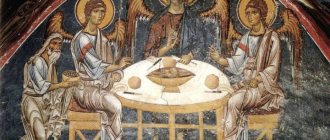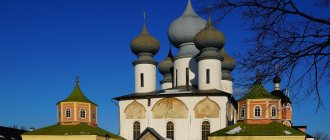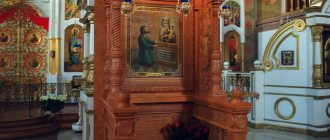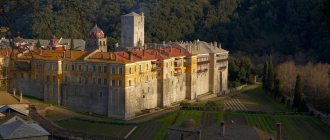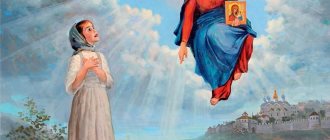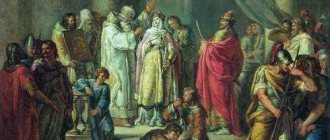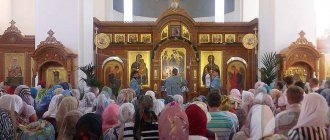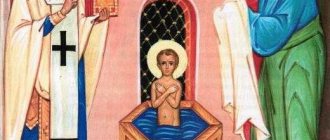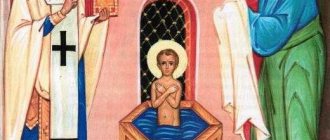The image, created by the famous artist and icon painter Andrei Rublev, is considered the most mysterious and original image of God in Russian traditional iconography. Many researchers in the field of Orthodox iconography regard the “Trinity” not just as an image, an attempt to graphically depict the greatness of the Higher Powers, but as a prayer written in colors; as a theological treatise dedicated to the Trinity depicted in the icon. Now many Christians agree that no one could initiate believers so deeply into the mystery of the Trinity as St. Andrew did.
Andrey Rublev "Trinity"
A little theology: who is depicted in the icon
Before us is an image of the Holy Trinity, as a rule, thoroughly symbolic. Each icon painter conveyed to the viewer his vision of the visualized dogma of Christianity. If in some images it is often clear to the viewer who is which of the divine characters, then in others the differences between them are erased.
Not in every image of the Trinity do we see the personification of all three hypostases of God. Often, instead of human figures, icons depict flames or a dove, symbolizing the Holy Spirit. Invariably, only Jesus Christ is depicted in human form on most icons.
The Holy Trinity. Greece. End of the 12th century
Theologians are still debating whether this or that image corresponds to church canons. The most global subject of discussion is the image of God the Father. Unlike Jesus Christ, no one has seen God the Father, so how can his appearance be conveyed? - say some theologians. Others object to them, quoting the words of the Savior: “He who has seen me has seen my Father.”
From a human point of view, God the Father must a priori be older than his own son. But in 1667, the Moscow Council forbade depicting the Father in the image of an old man. However, icons with the Elder Father still exist.
Therefore, the oldest images of the Trinity that have come down to us (and these are frescoes of the 2nd century AD) belong to the type of Old Testament icons, that is, they depict three men. A little later, the Divine Trinity began to be displayed in the form of three angels, and after the 16th century its image became more symbolic and plotless.
New Testament icons include more or less narrative iconographic types, for example, “Co-throne” and “Fatherland”. They contain images of the Father and the Son (by the way, the Father usually appears in the form of an old man), but the Holy Spirit is depicted in the form of a dove.
On the left is the “Co-throne”, on the right is the “Fatherland”.
The thoroughly allegorical “All-Seeing Eye”, “Eternal Light”, “Sex Day” and others like them are also considered New Testament. Many theologians believe that these images cannot be classified as icons at all, but this does not prevent ordinary people from worshiping various types of visualized images of the Trinity.
History of writing the icon
The most famous icon of the Trinity was painted by the icon painter Andrei Rublev, famous for centuries. Despite the fact that many centuries have passed since the creation of the masterpiece, its authorship is practically beyond doubt. Sometimes alternative hypotheses are put forward, but no serious confirmation is found.
According to one hypothesis, the creator of the icon was an unknown Italian icon painter. This is proven by the analysis of the icon, in which the influence of the Italian school of painting is clearly noticeable. Allegedly, Ivan the Terrible himself brought this image to the Lavra. However, according to the official version, thanks to the monarch, the icon only received a luxurious robe.
In general, the creation of the Trinity icon by Andrei Rublev is considered a generally accepted fact. According to the official version, the icon painter created it at the behest of Abbot Nikon, in praise of Nikon’s legendary predecessor, Sergius of Radonezh.
It was in a monastery that later became known as the Trinity-Sergius Lavra. And the image was intended for the new Trinity Church, erected to replace the burnt wooden church of the same name.
Scientists have different opinions about the year the icon was created - either 1411 or 1425-1427. One thing is clear: the “Trinity” immediately took pride of place on the right side of the altar and began to serve as an object of worship. But the main shrine of the temple at all times was considered the relics of St. Sergius of Radonezh.
Andrey Rublev. "Trinity".
"Trinity" has been updated several times. In fact, on top of Rublev’s images, icon painters painted new ones that corresponded to modern trends, even if they repeated the original plot. As a result, Rublev’s “Trinity” disappeared under numerous layers of paint.
And only at the beginning of the last century, after removing the chasuble and several openings (freeing from later layers of paint), Andrei Rublev’s masterpiece appeared before admiring spectators as the genius intended it.
The icon has suffered greatly from time to time: it is painted on a wooden board, and this is not a very durable base. However, the bright festive colors, lovingly painted by Rublev’s brush, still delight the eye of a true connoisseur of art.
Where is the original icon located?
After the revolution, the icon was nationalized and removed from the closed Trinity-Sergius Lavra. It went first to the museum, organized in one of the buildings of the former monastery, and then to the Tretyakov Gallery fund. The Rublev Trinity resides there permanently, with the exception of its forced evacuation during the Great Patriotic War.
And in the Sergius Lavra there is now a list of the “Trinity”, written by Nikolai Baranov in the last century.
The original icon is placed in a special icon case and stored in special conditions: an optimal temperature and humidity regime has been created for it. And only once a year, on Trinity Sunday, it is taken with unimaginable care to the temple-museum at the Tretyakov Gallery.
Representatives of the Russian Orthodox Church have repeatedly raised the issue of returning the Trinity to the Lavra. However, art historians have proven that transportation can cause irreparable damage to a masterpiece of Orthodox icon painting, let alone storage under normal conditions. “Trinity” was left in the Tretyakov Gallery.
Icon "Trinity" in the hall of the Tretyakov Gallery
Many works attributed to Rublev do not belong to him
The “discovery” of Andrei Rublev occurred in the 19th century, when the growth of Russian national consciousness began in the run-up to the First World War. At the same time, since little information about the icon painter has been preserved, many of the works attributed to him turned out to be fake or not by him.
This is also due to the fact that Rublev’s icons were recognized by the Russian Orthodox Church as standard icons and therefore were copied in large quantities. The Apostle Paul and Archangel Michael were especially often depicted “like Rublev.”
Video: Levon Nersesyan about Andrei Rublev. In the first minute, the author says that the only work that belongs 100% to Andrei Rublev is the Trinity icon, since there are mentions of it in handwritten sources.
Art historians have found that today there are only seven works of art of which it is reliably known that their author was Andrei Rublev. These are both frescoes and icons. Another 15 works are controversial, but still, based on the manner of writing, they are classified as Rublev’s.
In addition, there are many different copies and imitations. In our time, icon photographs of Andrei Rublev are often sold as souvenirs in cultural and religious centers of the country.
Today there are 7 works for which the authorship of Andrei Rublev has been reliably established.
Art historians most often talk about the icons “Trinity”, “Savior Not Made by Hands”, “Annunciation”, “Our Lady of Vladimir”, “Transfiguration of the Lord”. This is an example of the “Rublev style”.
Many modern icon painters, reviving the traditions of Russian icon painting, lost during the Soviet period, take these works of St. Andrew as a model.
Iconography
Let us give a brief description of the Trinity in the form in which Andrei Rublev showed it to us. The plot of the icon speaks of the Old Testament history, which laid the foundation for one of the main dogmas of Orthodoxy.
According to a text from the Old Testament, Abraham was once visited by three mysterious travelers. He sat them down at the table and treated them to various dishes, for which he was awarded the revelation of the birth of Isaac. Two travelers soon left (according to legend, to punish the city of sinners Sodom), and one remained to talk with the future founder of the Jewish people.
The most ancient versions of the icon depict male travelers in a realistic form. The images contain the figures of Abraham and his wife Sarah, and the surroundings of the action are documented.
Rublev's icon looks a little different. The artist depicted the Trinity in the form of angels similar in appearance, but there are no images of Abraham and his wife Sarah in the composition.
Angels sit at a table on which stands a bowl with the head of a sacrificial animal - a reference to Christ's sacrifice for humanity. The angels are exactly the same, which hints at the trinity, but behind each one there is a personal background.
Behind the back of the central angel is written a tree (Tree of Life, an allegorical image of paradise lost). Usually this image is identified with God the Father. Behind the back of the angel sitting on the left is a temple (symbol of the Holy Spirit), sitting on the right is a mountain (symbol of Golgotha and the feat of Jesus Christ). Nevertheless, there are other interpretations of the deepest symbolism of the image.
The images seem to be united in an invisible circle. And at the table there is a free place where the person looking at the icon mentally sits. This is a symbol of the invitation addressed to each of us: there is a place for everyone at the table next to God.
Thus, it turns out that not the personified Father, Son and Holy Spirit are depicted at the table, but the angels symbolizing them. The artist gives visual clues, but the viewer is asked to figure out for himself which of these angels is which.
Simon Ushakov
Simon Ushakov, Yakov Kazanets, Gavriil Kondratyev. Annunciation with Akathist. 1659. State Historical Museum, Moscow
Simon Ushakov. Savior Not Made by Hands. 1658. State Tretyakov Gallery, Moscow
Simon Ushakov. Tree of the Russian State. 1668. State Tretyakov Gallery, Moscow
The court painter Simon Ushakov worked in the second half of the 17th century. His works reflected the fashion for everything Western and introduced a new style into Russian icon painting. The faces of the saints became more rounded, their features softer, and their complexions approached a warm, flesh-colored complexion. The artist began to depict buildings as realistic. His works were reminiscent of Western European engravings, but the composition still remained conventional and there was no light source.
At first, Ushakov served as a “royal paid icon painter” and quickly became popular. In 1664, he already supervised the craftsmen of the Armory Chamber, the main art center of Russia at that time. Its artists painted palaces and churches, created icons and miniatures. It was Simon Ushakov who embodied the method of joint work: one artist came up with the composition of the icon, the second painted the faces of the saints, the third painted the clothes and background. Thus, Ushakov painted the icon “Annunciation with Akathist” together with Yakov Kazanets and Gavriil Kondratyev.
A typical example of Ushakov’s “life-like” icon is “The Savior Not Made by Hands” for the Moscow Trinity Church in Nikitniki. There, the artist created his own version of the Mother of God of Vladimir - “Tree of the Russian State”. On the icon, the roots of the tree “grow” from the Assumption Cathedral, portraits of twenty Moscow saints are inscribed on the branches in medallions, and in the center medallion there is an image of the Mother of God.
The meaning of the Holy Trinity icon
This image means, first of all, the visualization of the idea of the trinity of God. The Life-Giving Trinity is something united and whole, which is one of the basic dogmas of Christianity.
As mentioned above, there are many images of this type, from realistic to completely symbolic. Many of them are not recognized as canonical and, from the point of view of the official church, are simply paintings on religious themes. But what can we say, even if Rublev’s “Trinity” still causes a lot of theological controversy!
Nevertheless, the main meaning of the icon, no matter what means it is conveyed, remains unchanged: the trinity of God. And among the many additional meanings, one more can be identified, important for every believer: the road to the Kingdom of Heaven is open for each of us.
Childhood and youth
The icon painter was allegedly born in 1360 on the territory of the Moscow Principality (other sources indicate Veliky Novgorod as Rublev’s birthplace). Information about the artist’s childhood, youth and family is extremely scarce. Historians and art historians, based on the surname Rublev, have suggested that Andrei’s ancestors on his father’s side are artisans.
Monument to Andrey Rublev
The name Andrei Rublev was given after his monastic tonsure in a monastery on the left bank of the Yauza, known to us as Andronikov. The worldly name of the artist is not known. Researchers agreed that Andrei Rublev’s patronymic was Ivanovich: on the surviving icon of that time, they could discern the signature “Andrei Ivanov son Rublev.”
How does the image help believers?
This image is not as popular among believers as icons of the Savior, the Mother of God and even especially revered saints (for example, St. Nicholas). Nevertheless, the image of the “Trinity” is in many churches and houses of believers, and Trinity churches were built in almost all major cities Russia.
Sincere prayer to the icon helps:
- improve health, get rid of diseases and addictions;
- get a hint in a difficult life situation;
- strengthen in faith and take the path of piety;
- comfort after a difficult loss;
- to receive the fulfillment of your most cherished desire (of course, if it is not directed towards evil).
The most powerful prayers are for those who have strong faith. Before asking something from the Life-Giving Trinity, it is advisable to fast, confess and take communion - in a word, to purify yourself as much as possible before the face of the Lord.
Silver pendant "Holy Trinity"
The most significant miracle in the history of the icon is considered to be its assistance to Ivan the Terrible during the capture of Kazan. Before sending troops to the heart of the Khanate, Ivan Vasilyevich ordered a prayer service to be held in the Trinity-Sergius Lavra. And after the fall of the considered inaccessible stronghold, the monarch prayed to the icon in person for a long time, praising the Trinity. It was then that the image received its first precious robe.
Icon day celebration
Unfortunately, the Trinity icon never received its own holiday. Most likely, this is due to the ambiguous attitude of the Orthodox clergy towards this graphic representation of the Divine Trinity.
However, there is a major church holiday - Trinity Day, which is celebrated on the fiftieth day after Easter (hence the alternative name - Pentecost).
It is believed that on this day the truth about the trinity of God was revealed to humanity. True, it is associated not with the Old Testament, but with the Gospel event. On this day the descent of the Holy Spirit on the apostles took place.
In accordance with the Old Testament and the Pentateuch, on this day the prophet Moses received the Tablets on Mount Sinai. They contained the Ten Commandments of God, by which a God-obedient Jew (and later a Christian) must live.
During the Battle of Kulikovo, Andrei Rublev was a member of the princely artel of craftsmen
Indirect information from various sources suggests that the future famous icon painter was already a member of the princely artel of masters during the Battle of Kulikovo in 1380.
This artel was engaged in the construction and decoration of temples and monasteries. She did not live constantly in one place, but moved from city to city.
Annunciation Cathedral of the Moscow Kremlin. Andrey Rublev. Icon "Transfiguration", 15th century. The first mention of Andrei Rublev in the Russian chronicle dates back to 1405
Unfortunately, ancient Russian artists did not sign or date their icons. Therefore, Rublev’s life path can be traced only from the meager information preserved in the chronicles. However, such information contradicts each other.
Other famous icons of the Holy Trinity
Rublev’s masterpiece is the most famous, but far from the only one of the ancient icons of the Holy Trinity. This image was painted many times before and after it, and Rublev’s icon received numerous copies, sometimes far from the prototype.
For example, the so-called Zyryan icon, painted back in the 14th century, supposedly by the enlightener Stefan of Perm, is known. The genius managed to convey the basic idea of the trinity of God in the most accessible form for the dark pagans, who were the Zyryans (Komi-Permyaks) at that time. The plot of the icon is quite classic (as in the image of Rublev), and the image is supplemented with a quotation from the Old Testament, translated into the Zyryan language.
The image of the Trinity of Theophan the Greek dates back to approximately the same period, although this is not an icon, but a fresco in the Church of the Transfiguration in Novgorod. In this work, there is a clear primacy of one of the angels (most likely symbolizing God the Father), and there is an image of Sarah. Obviously there was Abraham, but his image collapsed along with the plaster.
Theophanes the Greek. Fresco "Trinity".
The icon of Simon Ushakov was painted much later, already in the 17th century. It actually duplicates the plot of Rublev’s creation, but with some adjustments that bring it closer to secular painting. The mountain no longer symbolizes Golgotha or Mount Sinai (depending on the interpretation), God's temple has been turned into something antique, and the head of the sacrificial calf in the bowl has been replaced by a luxurious table setting.
The first time the name of Andrei Rublev appeared in the chronicle was in 1405.
The name of Andrei Rublev appears for the first time in the chronicle in 1405. The record says that he participated in the painting of the Annunciation Cathedral in the Moscow Kremlin together with Theophan the Greek and Prokhor the Elder.
At the same time, Andrei is called a Chernets in the text of the chronicle. Researchers claim that at this time the icon painter painted one of his best icons, the Transfiguration.
Apostle John the Theologian with his disciple Prokhor. Andrey Rublev (?), Khitrovo Gospel, 1392
His work on such a monument of Russian book art as the “Gospel of Khitrovo” dates back to the same time. Scientists claim that the initial letters and miniatures of the gospel belong to the pen of the monk.
It is believed that the customer of the masterpiece could have been either the Grand Duke or the Metropolitan himself.
The customer of the “Gospel of Khitrovo” could have been the Moscow Metropolitan himself.
The second time the chronicle speaks of Rublev is in 1408. Then the saint was sent to paint the Assumption Cathedral in Vladimir. Andrey did the painting together with master Daniil Cherny.
Icon painters, at the behest of Grand Duke Vasily Dmitrievich, carried out work to replace the lost parts of the cathedral frescoes.
Andrei Rublev was engaged in the restoration of a fragment of the grandiose fresco “The Last Judgment”, which occupied the western wall of the temple.
How to pray to the image correctly, where to place the icon in the house
According to Orthodox traditions, icons should be hung on the eastern side of the home, but if there is not enough space there, you can place the home altar on any other wall. It is better if there are no household appliances, worldly books and paintings nearby.
In the home iconostasis, the “Trinity” is usually placed above the central image of the Savior. If you wish, you can purchase an icon for your car or personal use. Or you can buy a bracelet or pendant with the image of the Life-Giving One.
Texts of prayers
There are many canonical prayers to the Holy Trinity, both asking and thanking. It is not necessary to learn them by heart (although it is advisable); you can carefully and respectfully read the text from a sheet or brochure.
Of course, God also hears sincere prayers uttered in his own words, but it is better not to replace them, but to supplement them with canonical texts.
Prayer of thanksgiving and majesty for the holiday of Trinity
In the name of the Father God, the Son and the Holy Spirit, we pray for forgiveness and mercy on this bright and festive day. Three times our only heavenly Father, we offer words of joy on this holiday, we are in Your house and bow to the images in the hope of instruction and deliverance from illnesses and sins that burden our souls. We proclaim the true faith and convey from mouth to mouth words of gratitude for our lives in Thy goodness and mercy. We pray for everyone living on earth, living under Your gaze. Bless, Lord, a righteous life in mercy and goodness. Grant us, God, to live it in reverence for You and in raising children according to Your indisputable and only righteous covenants. Amen.
Prayer for health and healing
O most merciful God, Father, Son and Holy Soul, worshiped and glorified in the indivisible Trinity, look kindly upon Thy servant (name), who is sickly possessed; forgive him all his sins; give him healing from his illness; restore his health and bodily strength; Give him a long and prosperous life, Your peaceful and exemplary blessings, so that together with us he brings grateful prayers to You, the All-Bountiful God and my Creator. Most Holy Theotokos, through Your omnipotent intercession, help me to beg Your Son, my God, for the healing of God’s servant (name). All saints and angels of the Lord, pray to God for His sick servant (name). Amen.
Prayer for fulfillment of desires
To the Most Holy Trinity, the Consubstantial Power, all the good Wines that we will reward You for everything that You have rewarded us sinners and unworthy before, before you came into the world, for everything that You have rewarded us every day, and that You have prepared for all of us in the world to come ! It is fitting, then, for so much good deeds and generosity, to thank Thee not just in words, but more than in deeds, for keeping and fulfilling Thy commandments: but we, being aware of our passions and evil customs, have cast ourselves into countless sins and iniquities from our youth. For this reason, as unclean and defiled, do not just appear before Your Trisholy face without coldness, but below Your Most Holy Name, speak to us, even if You Yourself had deigned, for our joy, to proclaim that the pure and righteous are loving, and sinners who repent are merciful and kindly accept. Look down, O Divine Trinity, from the height of Your Holy Glory upon us, many sinners, and accept our good will, instead of good deeds; and give us the spirit of true repentance, so that, having hated every sin, in purity and truth, we may live until the end of our days, doing Your most holy will and glorifying Your sweetest and most magnificent name with pure thoughts and good deeds. Amen.
It should be remembered that the icon of the Trinity is not a painting or a talisman. This is a sacred relic intended for communication with God. It definitely shouldn’t be hung on the wall just for beauty, and the holy image will show miracles only when the person praying deeply and wholeheartedly believes in God!
16.09.21
Prayer to St. Andrei Rublev
Nowadays, people pray to the saint for the discovery of talent and help in work.
O sacred head, reverend father, most blessed Abbot Andrew! Do not forget your poor to the end, but always remember us in holy and auspicious prayers to God:
remember your flock, which you yourself shepherded, and do not forget to visit your children, pray for us, holy father, for your spiritual children, for you have boldness towards the Heavenly King:
do not keep silent to the Lord for us, and do not despise us, who honor you with faith and love: remember us unworthy at the Throne of the Almighty, and do not stop praying for us to Christ God,
for grace was given to you to pray for us.
We do not imagine that you are dead: even though you have passed away from us in body, but remain alive even after death, do not depart from us in spirit,
keeping us from the arrows of the enemy and all the charms of the devil and the snares of the devil, our good shepherd.
Even though your relics are always visible before our eyes, your holy soul is with the angelic hosts, with disembodied faces,
with the heavenly powers, who stand at the throne of the Almighty, rejoice worthily, knowing that you are truly alive after death,
We bow down to you and pray to you: pray for us to Almighty God, for the benefit of our souls, and ask us time for repentance,
may we pass from earth to heaven without restraint, may we be delivered from bitter ordeals, demons of the princes of the air, and from eternal torment,
and may we be heirs of the Heavenly Kingdom with all the righteous who have pleased our Lord Jesus Christ from all eternity:
To Him belongs all glory, honor and worship, with His Father without beginning,
and with His Most Holy and Good and Life-giving Spirit,
now and ever, and unto ages of ages. Amen.
By leaving a comment, you accept the user agreement
